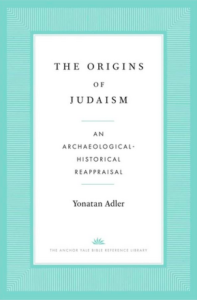By Rabbi Dr. Israel Drazin

BOCA RATON, Florida — The question of when did Jews begin to observe the practices and prohibitions of biblical laws is one of the most important yet thorniest questions that has bothered scholars for centuries. While traditional Jews believe their ancestors accepted and practiced Torah laws since the time of Moses, there is no clear statement that this occurred in the Bible itself. Associate Professor Yonatan Adler of the Department of Land of Israel Studies and Archaeology at Ariel University in Israel addresses this age-old question. His reply, supported by multiple sources, is contained in his 2022 book, The Origins of Judaism: An Archaeological Historical Reappraisal, a scholarly, easy-to-read Yale University Press book. Several hundred interesting notes follow the 236-page book in 64 pages, a bibliography of 30 pages, and an extensive, helpful index of 34 pages.
Adler’s goal in this very informative and eye-opening book is not to examine when, why, and by whom the Torah was written or answer any other theological question. His focus is on the behavior of the Judean society, when we can identify the time when Judeans observed the Torah. Many scholars argued previously that the early Judeans did not obey Torah law, but they did not identify when Jews accepted the Torah as a director of their lives. For example, I wrote in my book “The Tragedies of King David,” “Scholars contend that there are many indications in the book of Samuel that the book’s author knew nothing about Moses’s Torah, and may not have known about the biblical books of Joshua and Judges. I identified 39 such indications in my two prior books about Samuel and David. There are an additional 18 in this volume, 57 in all.” In later books on the Bible, I showed more examples.
 Adler examines 13 practices, dietary laws, ritual purity, artful portrayals of humans and animals, tefillin and mezuzot, the synagogue, circumcision, the Sabbath prohibitions, the Passover sacrifice, the Festival of Unleavened Bread, fasting on the Day of Atonement, residing in booths on Sukkot, the four species, and having a continually lit seven-branched menorah in the Jerusalem temple. In each case, he begins by telling the law as specified in the Pentateuch, the five books of Moses, examines the evidence for the practice or prohibition in the first century CE, both writings by Jews and non-Jews of this time, such as Philo, Josephus, Dead Sea Scrolls, the New Testament, Roman writers, as well as archeological finds of the period, such as coins, pottery, buildings, and bones, and continues backward in time to earlier available writings and archeological evidence before the first millennium, until there is no evidence that people observed these practices.
Adler examines 13 practices, dietary laws, ritual purity, artful portrayals of humans and animals, tefillin and mezuzot, the synagogue, circumcision, the Sabbath prohibitions, the Passover sacrifice, the Festival of Unleavened Bread, fasting on the Day of Atonement, residing in booths on Sukkot, the four species, and having a continually lit seven-branched menorah in the Jerusalem temple. In each case, he begins by telling the law as specified in the Pentateuch, the five books of Moses, examines the evidence for the practice or prohibition in the first century CE, both writings by Jews and non-Jews of this time, such as Philo, Josephus, Dead Sea Scrolls, the New Testament, Roman writers, as well as archeological finds of the period, such as coins, pottery, buildings, and bones, and continues backward in time to earlier available writings and archeological evidence before the first millennium, until there is no evidence that people observed these practices.
Adler found that “the earliest surviving evidence for a widely practiced Judean way of life governed by the Torah never predates the second century BCE.” The evidence suggests that the early Hasmonean leadership who rescued the Judean nation from Syrian Greek control, legitimized the Pentateuch as the authoritative law and fashioned themselves as the “restorers” of an ancient system of divine law. They went so far as to convert the Semitic people they conquered forcibly. They were the first who converted people. There was no need for conversion previously. The Hasmonean family led the revolt against the Syrian Greeks around 167 BCE. The last of the brothers, Simon, became high priest and leader of the Judeans in 142 BCE when he established an independent country led by his descendants until the Hasmonean state fell to the Roman general Pompey in 63 BCE.